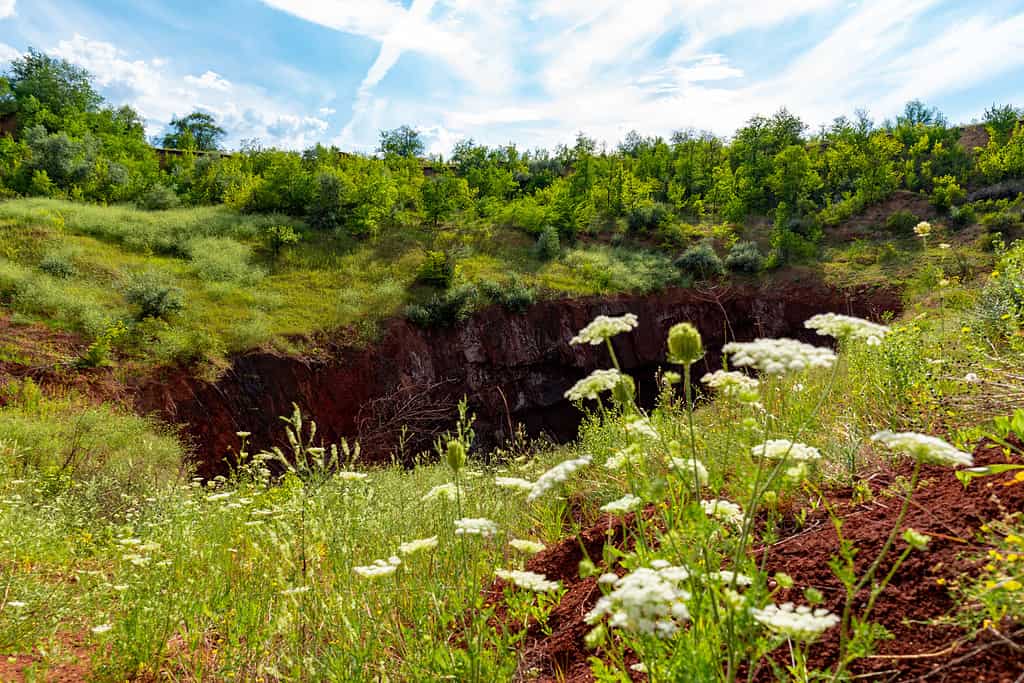Massive holes in the ground that appear overnight, swallowing everything in their midst sound like something straight out of a horror movie. But nature is wild! And this is a natural occurrence called a sinkhole that happens when superficial layers collapse, creating a depression in the earth. Sometimes sinkholes cause minor damage and only end up a few feet deep. However, on some occasions, the holes reveal shocking depths. This became true during the establishment of the largest sinkhole in Alabama.
The Golly Hole in Shelby County, Alabama

Sinkholes happen when superficial layers of the earth collapse.
©Alex Floston/Shutterstock.com
On December 2, 1972, in Shelby County, Alabama, residents Herschel and Nora Byrd heard the sound of trees crashing. Though unusual, they didn’t go out to find the cause of the sound. It wasn’t until a few days later when several neighbors were out hunting that they came across the cause of the unusual sounds. The Golly Hole also became known as the “December Giant.” It is now recognized as the largest sinkhole in Alabama. In addition, it is recognized as one of the largest sinkholes in the United States.
It measured about 300 feet wide and 325 feet long. Its depth was measured around 120 feet, but some believe it could be even bigger. Luckily for locals, the sinkhole didn’t cause any property damage. It only took trees down with it. There is no national tracking of sinkhole damage. However, it’s estimated by the U.S. government that sinkhole damages cost an average of $300 million per year. Sinkholes have taken down entire homes, several vehicles at once, and even entire gasoline trucks.
How Did the Golly Hole Form?
The Golly Hole is a sinkhole and is the largest sinkhole in Alabama. A sinkhole refers to a hole formed in an area where there is no drainage at the surface. These form because rainwater has nowhere to flow other than downward. Sinkholes are typically formed in certain regions where the type of rock beneath the surface can easily be dissolved by the water draining downward. Some examples of dissolvable rocks include carbonate rocks, salt beds, and limestone. As the water makes its way down into these soluble rocks, it starts to eat away at it, forming little caverns. Although the occurrence of a sinkhole may appear sudden and unexpected, it has been forming below the surface for some time before the collapse happens.
The Golly Hole formed in one such environment where susceptibility to sinkholes was high. This area was made up of limestone and at the time, there had been industrial watering along with drought conditions. With these factors working in tandem, the clays within the soil began to diminish and deteriorate. The groundwater had more space to stream through the soluble limestone, which eventually gave way to the sinkhole known today as the largest and certainly creepiest in Alabama.
Where Is Shelby County Located on a Map?
Shelby County is situated in the Appalachian Mountains’ foothills, around 24 miles’ drive south of Birmingham. The county is named after the former governor of Kentucky Isaac Shelby. Its seat is Columbiana, its biggest city is Alabaster, and it is part of the Birmingham–Hoover, AL Metropolitan Statistical Area.
The photo featured at the top of this post is © Andriy Blokhin/Shutterstock.com
Thank you for reading! Have some feedback for us? Contact the AZ Animals editorial team.







